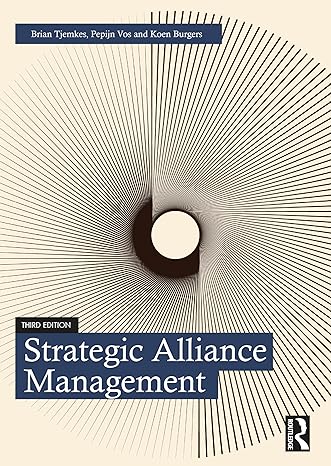The airline industry is characterized by ferce competition between airlines and high levels of regionalization, owing to
Question:
The airline industry is characterized by ferce competition between airlines and high levels of regionalization, owing to national ties between airlines and their country of origin. This translates into restrictions on landing rights and routes. Despite the deregulation of recent decades, no single airline in the world is able to provide a global network. In order to build and maintain a competitive advantage, airlines circumvent these strict regulations through collaboration. For example, bilateral agreements, such as code sharing, allow airlines to share their network, which enables passengers to complete a journey involving multiple airlines using just one ticket. However, having recognized that bilateral agreements were insuffcient to maintain their growth strategies, airlines started to initiate and participate in multi-partner alliances.
The establishment of the Star Alliance in 1997 by United Airlines, Lufthansa, Air Canada, Thai Airways and Scandinavian Airline System (SAS) constituted the frst global airline network. The Star Alliance example was soon to be followed by the Oneworld alliance in 1999. SkyTeam was the third alliance to be created in 2000.1 The primary motivation for SkyTeam was to create a globe-spanning network of routes and airports. Therefore, the most important contribution that partners within the SkyTeam alliance make is their network of routes and airports. Initially, SkyTeam consisted of four founding airlines: Aeroméxico, Air France, Delta Airlines and Korean Air. In 2001, KLM merged with Air France, while in the North American market, Northwest and Continental airlines had already formed a partnership. This partnership was expanded with Delta Airlines forming an important North American bloc. Within Europe, Air France and Alitalia were part of the SkyTeam alliance. The merger between KLM and Air France strengthened the European bloc. Combining both blocs within SkyTeam provided SkyTeam with a key asset: transatlantic routes. SkyTeam currently consists of Aerofot, Aeroméxico, Air Europa, Air France, Alitalia, China Southern Airlines, Czech Airlines, Delta Airlines, Kenya Airways, KLM, Korean Air, TAROM and Vietnam Airlines, offering a worldwide network. This constellation of multiple airlines presented SkyTeam with the challenge of aligning varying interests and preventing dysfunctional behaviour such as free riding. By carefully selecting its partners and requiring them to pay a membership fee, and incorporating active alliance management and specifc decision-making structures, SkyTeam was able to ensure alliance viability.
SkyTeam developed an extensive partner recruitment policy consisting of multiple stages. The primary criteria for selecting potential partners are (1) the network the potential partners can contribute to the alliance and (2) the access a partner can provide to new markets in, for instance, developing regions and countries. In other words, SkyTeam reduced internal competition by minimizing substitution of routes and airports within the alliance. Guided by these criteria and building on the results of preliminary assessments, SkyTeam may decide to proceed to the next stage, introducing a new member of the SkyTeam alliance. During this next phase, the alliance terms and conditions are discussed. An important factor in this negotiation phase is the partner’s ability to meet SkyTeam’s requirements. These requirements cover aspects concerning fight safety, airline organization and IT infrastructure. The time it takes to fulfl these requirements means the negotiation phase typically takes between one and two years. Meeting these requirements sometimes requires airlines to make signifcant changes and investments within their organization and operations. Becoming a member of an airline alliance is often critical for long-term airline viability, so airlines are willing to make Multi-partner alliances 265 these investments. In most cases, SkyTeam appoints a buddy airline (sponsor) that helps the airline meet the SkyTeam requirements. Through this buddy system, new partnership members are introduced to partnership rules and routines, translating into easier integration within the alliance. In addition to the process of becoming a member of SkyTeam, partners must also agree to pay an alliance fee. This fee covers general alliance expenses such as marketing, communication and management costs.
Questions 1 Explain how competition is diferent in the airline industry for autonomous frms than for groups of frms connected through a multi-partner alliance.
2 Why is free riding a typical exchange hazard for multi-partner alliances? Assess the quality of the measures that SkyTeam took to prevent it.
3 Under what conditions is decentralized or centralized governance more likely to result in superior performance for individual alliance members and the multi-partner alliance?
Step by Step Answer:

Strategic Alliance Management
ISBN: 978-1032119250
3rd Edition
Authors: Brian Tjemkes ,Pepijn Vos ,Koen Burgers






